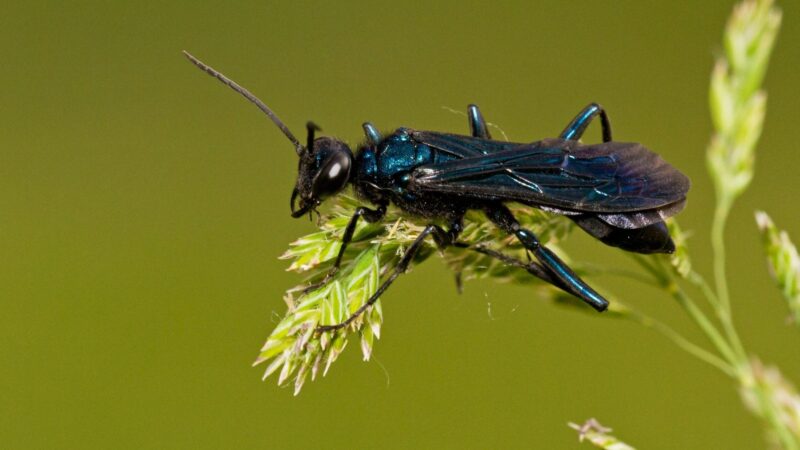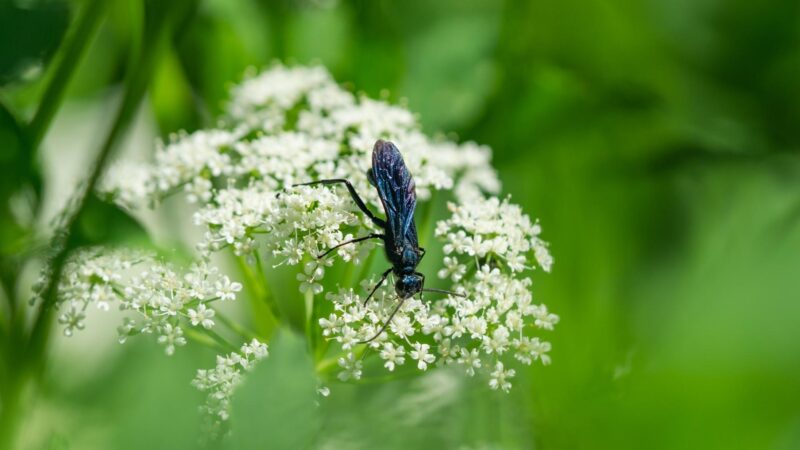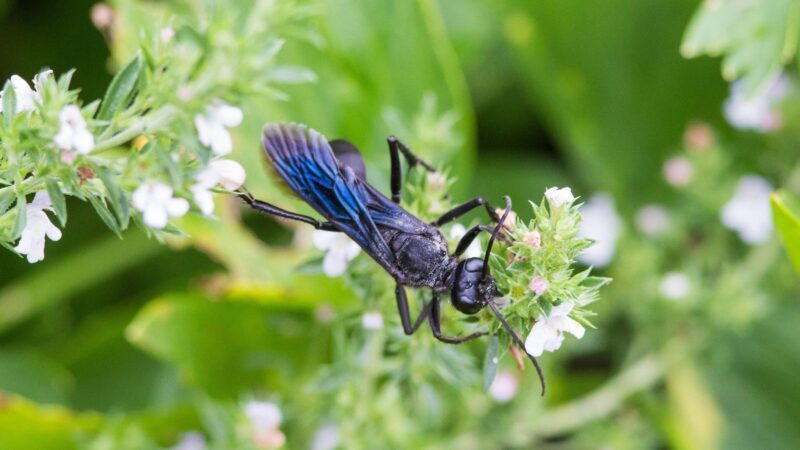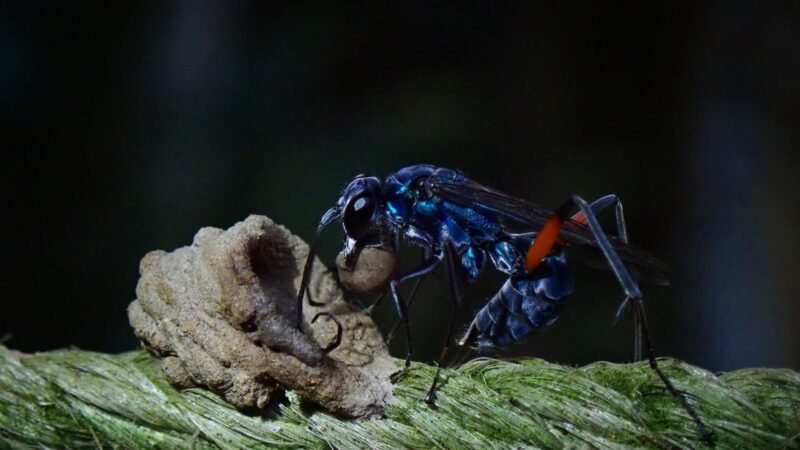Black widow spiders excrete venom that is extremely potent and may even cause human deaths. Controlling their populations usually includes extensive sanitation and several chemical spray barriers in or around homes and buildings. However, there is also a natural way of reducing black widow populations through certain wasp species.
Blue mud wasps are solitary wasp species that feed on several spider species. Aside from black widows, they also consume orb-weavers, lynx spiders, crab spiders, and comb-footed spiders. They are not known to be aggressive or territorial and are usually harmless to humans unless extremely provoked.
This article will provide you with everything you need to know about blue mud wasps, what they look like, what they do, where they live, their potential dangers (if any), and other interesting information. Make sure to read further to gain new knowledge today!
Table of Contents
What Is a Blue Mud Wasp?

Also referred to as the blue mud dauber, it is a solitary wasp that is active during the summer. It is not known to be aggressive compared to most wasp species. They are usually found under overhangs like building eaves.
What Do Blue Mud Wasps Look Like?
Blue mud wasps are blue-green, metallic blue, or blackish. Males are smaller than females but both have similar body structures: short and narrow waists, slight body bristles, black legs and antennae, and opaque wings.
Male blue mud wasps are usually 9 to 13 millimeters in length, while females are 20 to 23 millimeters. Like other wasp species, males lack an ovipositor or a tube-shaped organ that is modified to act as a stinger.
Are Blue Mud Wasps Carnivores?
Blue mud wasps are omnivores. They feed on insects and are also known to be pollinators as they consume the nectar of common wildflowers such as wild carrot (Daucus carota), golden Alexander (Zizia aurea), and common barberry (Berberis vulgaris). They also consume honeydew that is secreted by insects.
Developing larvae of blue mud wasps are usually fed high-protein meals, such as spiders. On the other hand, adults will feed on flowers as floral nectar gives them the energy they require for flight.
What Do Blue Mud Wasps Do?

Blue mud wasps serve important ecological functions such as being pollinators of common wildflower species, controlling spider populations, and reforming nests made by black and yellow mud wasps.
Where Do Blue Mud Wasps Live?
Blue mud wasp nests are usually found under overhangs like eaves of buildings, open sheds or garages, porch ceilings, attics, and barns. They can also be found in a variety of other habitats that are abundant with flowers, spiders, potential nesting areas, and little water.
Its range is from Northern Mexico to Southern Canada, and it has been introduced in Bermuda and Hawaii. It is most commonly found during summertime around the state of Michigan, especially in the Great Lakes region.
Where Do Mud Daubers Go in Winter?
Usually, most adult solitary wasps do not go anywhere during the winter season. They complete their reproductive duties and die while their larvae will develop or overwinter inside their nests and emerge in the following spring season as full-fledged adults. The new generation of wasps will then repeat the cycle.
Do Mud Daubers Make Noise?
Mud daubers make buzzing sounds while working or building nests. It is not considered a form of communication or defense mechanism. It is simply a byproduct of their movements, specifically when their wings are rubbing, hitting, or creating friction against the clay walls of the tubes inside their nests.
Are Blue Mud Wasps Dangerous?

Blue mud wasps are harmless to humans. They do not defend their territories, unlike other social wasps, such as yellowjackets and hornets, who would sting if you come in proximity to their nests.
Do Blue Mud Wasps Bite or Sting?
Blue mud wasps do not bite, but they can sting—only if they are mishandled or extremely threatened, and if they do, only female blue mud wasps can sting. Otherwise, they are very unlikely to sting, even when they are in a state of complete arousal.
Can Blue Mud Wasp Venom Hurt You?
Blue mud wasps’ venom is harmless to humans. It is used to capture and paralyze prey, such as spiders, and is not used as a defense mechanism against humans, other wasp species, and bees.
However, some people can have an allergic reaction to the blue mud wasp’s venom. They can develop symptoms such as pain or tingling in the stung area, redness, itching, or swelling. In worst-case scenarios, such as when experiencing difficulty breathing, hives, or loss of consciousness, this will warrant a trip to the nearest emergency room.
How to Treat a Blue Mud Wasp Sting?
If you are not allergic to blue mud wasp venom, you may not even display any symptoms, or you would most likely develop mild symptoms only. In this case, you can do the following:
- Clean the stung area with soap and water.
- Apply a cold compress.
- Use a topical cream to soothe the area if it becomes itchy.
- Take over-the-counter pain relievers if necessary.
Where Do Blue Mud Wasps Nest?

Blue mud wasps construct their nests in or around homes, barns, and sheds, as well as under open structures, buildings, and bridges. They can also be found stuck to building walls and on the sides of unattended equipment such as unused machinery and electric motors.
How Do Blue Mud Wasps Build Their Nest?
Blue mud wasps, specifically the females, reuse or even steal nests that are built by other species of mud wasps, such as the black and yellow mud dauber wasp. This happens during the summertime season.
What Is Inside a Mud Dauber Nest?
Before remolding the nest to its liking, the female blue mud wasp will first remove the existing larvae and prey (usually spiders) placed by other mud wasps. Then, they will form new tube-like mud chambers using collected mud and water, stock them with new spiders, lay a single egg, and finally, close the chambers with more mud. The resulting nest is a rather lumpy version of the original smoothly-built nest.
Does a Blue Mud Wasp Really Kill Black Widows?
Blue mud wasps can really kill black widows. Adult blue mud wasps typically feed on spiders. Aside from black widows, other common spider prey is the following:
- Orb-weavers (Araneidae family)
- Lynx spiders (Oxyopidae family)
- Crab spiders (Thomisidae family)
- Comb-footed spiders (Theridiidae family)
How Do Blue Mud Wasps Capture Black Widows?
- If black widows are already abundant in their nest areas, the blue mud wasp can successfully land on their web without getting tangled inside it.
- The wasp will pluck the web with their arms to provoke the spider living on the web.
- The spider will then rush to capture the prey on its web, thinking it is an easy catch of another insect, but quickly becomes victim to the wasp’s sting. The blue mud wasp will paralyze the spider using its specialized stinger, excrete venom, and carry its victim back to its mud nest.
- Once the wasp reaches its nest, it will store the spider at the bottom of a mud cell and produce a single egg onto its body to kickstart its reproductive cycle.
- When the larva hatches, it will consume what is left of the spider’s body. After this, the larva will spin itself into a silken cocoon inside the mud nest and enter its pupal stage. An adult wasp will emerge in the next spring and exit the mud cell.
When Is Mating Season for Blue Mud Wasps?
Although little is known about the courtship or mating behavior of blue mud wasps, they most likely mate before or during summer, just in time for females to build nests, stock them with spiders, and lay a single egg. In a single year, there can be multiple generations of wasps produced.
Do Mud Daubers Live Alone?
Mud daubers do live alone. They are a solitary wasp species. However, they may also be found in groups, specifically when sheltering themselves under a rock or in the shadow of buildings during nighttime or during unfavorable weather conditions.
How Do You Get Rid of Blue Mud Wasps?
There is no tested and proven method that can be used to control mud dauber wasp populations. However, if they are a nuisance to you or your community, you can use wasp and hornet aerosol sprays to treat nests and promptly kill the wasp and its larvae inside. Then, you can scrape their nests off at night and properly dispose of them.
Removal of blue mud wasp nests is not advised as they are beneficial in removing and controlling the populations of many spider species as well as other insects.
Summary
Blue mud wasps are known to feed on black widow spiders and are highly efficient in doing so. They are typically not aggressive towards humans and will only sting if they feel extremely threatened. They are usually found in or around homes, sheds, barns, as well as under open structures, bridges, and buildings. Removal of these wasps is not advised but can be done when they become a nuisance.